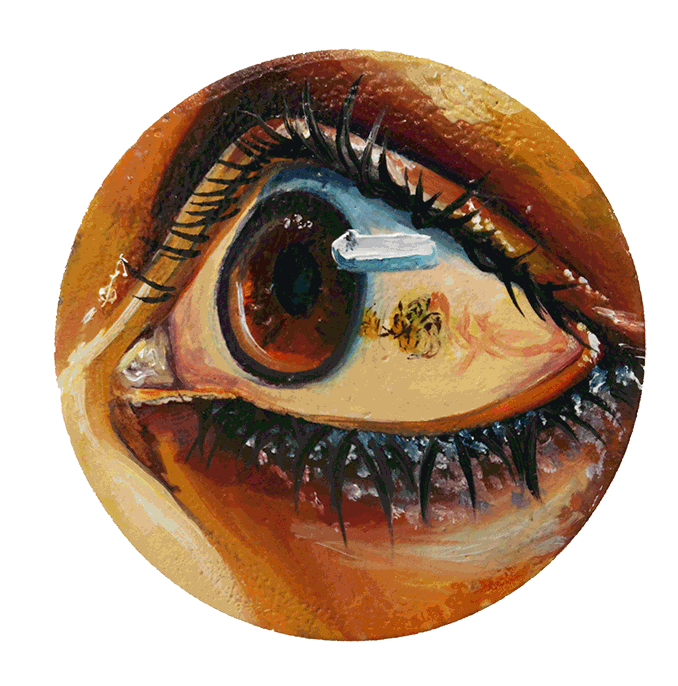"IN EXCESSIVE AWARENESS OF THE SELF, COMES DESTRUCTION OF THE SELF"
The collection of eyes is a depiction of social anxiety. The artist's internal itch of anxiety is imitated through visual cues; the sweat of immersion, the outside looking in, the self-criticality induced by the anxious discourse.
Playing with repeating scale, graphic imagery, and restriction of scale, the artist uses art as a tool to initiate self-reflection through immersion.
The miniature painting provokes intrigue and intimacy, luring in the audience to reconnect and redefine their fears and anxieties.
This series of 25 paintings is fluid and ever-changing, much like our understanding of the mind and our own reactions to fear and anxiety. Like anxiety, the work is unpredictable, changing with each space that it is displayed in.
Maintaining a certain degree of uncertainty is crucial to Madeleine's practice, as it ensures that intrigue and immersion is at a constant. Alongside this, the aim of re-curating the work each time it is displayed is that it remains out of the control of the audience and their ability to predict the work.
For the artist, eye contact is often a source of discomfort, but she recognises that the opposite is often the case for the public. For this reason, Madeleine has selectively reduced the quantity of direct gaze in the work to add an element of comfort for herself as well as discomfort for the viewer.





The fluidity in hanging comes from researching artists Matthew Krishanu and Rafael Gomezbarros.
Krishanu allows members of the curation team to have complete control over the display of his Crow paintings. Each painting is unique and spaced out from the rest, filling the gallery space without invading it, inviting the audience to scan the whole space for each of his works.
Gomezbarros, on the other hand, repeats his imagery in the House Taken (Casa Tomada) series. The series consists of hundreds of 'ants' made from wire and bones, which are draped across a building or gallery space. The ants are almost identical, creating scale through repetition and intimidating the audience. Unlike Gomezbarros, my work isn't didactic through intimidation, it is rooted in fear and horror and how these themes translate into our daily lives.
Utilising reaserch into both of these artists, my work sists somewhere in between, balancing peace, immersion, fear and repulsion.



Creating works with varying intensities of deatil has proved essential in understanding the psychological impulses the arise from encountering certain imagery.
Generally speaking, my practice is more focused on elements of representational realism, especially when discussing my paintings. The detail in my paintings is not present to function as a photograph, it is an attempt at archiving in the post digital age. Highlighting the idealisational qualities of traditional painting techniques and the softening of harsh borders and graphic imagery.
As an artist, I am constantly researching and admiring historial baroque and renaissance artworks. Their attention to detail and idealisation of portraits, still life and landscapes remains impressive nonetheless. Although there is not direct visual correlation to these works and artists like Willen van Aelst and Rachel Ruysch, my method of painting and materials remain completely traditional. Working slowly allows me to establish a strong element of realism as well as a deep connection with the artwork.
Detailled painting in this way allows my work to maintain clarity whilst also softening my chosen graphic subject matter.
From a psychological immersive standpoint, my idealised imagery acts as a tool somehwere between a virtual reality exposure and imaginal exposure therapies. The work sits within a sterile landscape and combined with the miniature collection, there is a loss of grounding in the real-world landscape thus creating a virtual reality of sorts. It is imaginal in that the paintings are abstract in placement and scale, larger than life but still small and approachable, the ability to use these elements as a psychological tool for immersion is critical to the technicality of the painting.
As discussed here, my prints play with exaggerated ambiguity to create abject qualities within the work.My series of paintings however, exist solely to be approached and interacted with, attempting to dispel repulsion and distance.


